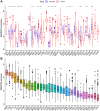Immunotherapy, prognostic, and tumor biomarker based on pancancer analysis, SMARCD3
- PMID: 38862250
- PMCID: PMC11210247
- DOI: 10.18632/aging.205921
Immunotherapy, prognostic, and tumor biomarker based on pancancer analysis, SMARCD3
Abstract
Background: SMARCD3 has recently been shown to be an important gene affecting cancer, playing an important role in medulloblastoma and pancreatic ductal adenocarcinoma. Therefore, we conducted this research to investigate the potential involvement of SMARCD3 across cancers and to offer recommendations for future studies.
Methods: Utilizing information on 33 malignancies in the UCSC Xena database, SMARCD3 expression and its prognostic value were assessed. The tumor microenvironment was evaluated with the "CIBERSORT" and "ESTIMATE" algorithms. SMARCD3 and immune-related genes were analyzed using the TISIDB website. The pathways related to the target genes were examined using GSEA. MSI (microsatellite instability), TMB (tumor mutational burden), and immunotherapy analysis were used to evaluate the impact of target genes on the response to immunotherapy.
Results: There is heterogeneity in terms of the expression and prognostic value of SMARCD3 among various cancers, but it is a risk factor for many cancers including uterine corpus endometrial cancer (UCEC), renal clear cell carcinoma (KIRC), and gastric adenocarcinoma (STAD). GSEA revealed that SMARCD3 is related to chromatin remodeling and transcriptional activation, lipid metabolism, and the activities of various immune cells. The TMB and MSI analyses suggested that SMARCD3 affects the immune response efficiency of KIRC, LUAD and STAD. Immunotherapy analysis suggested that SMARCD3 may be a potential immunotherapy target. RT-qPCR demonstrated the variation in SMARCD3 expression in KIRC, LUAD, and STAD.
Conclusion: Our study revealed that SMARCD3 affects the prognosis and immunotherapy response of some tumors, providing a direction for further research on this gene.
Keywords: SMARCD3; biomarker; immunotherapy; pan-cancer analysis; prognostic.
Conflict of interest statement
Figures






Similar articles
-
Pan-Cancer Analysis of PARP1 Alterations as Biomarkers in the Prediction of Immunotherapeutic Effects and the Association of Its Expression Levels and Immunotherapy Signatures.Front Immunol. 2021 Aug 31;12:721030. doi: 10.3389/fimmu.2021.721030. eCollection 2021. Front Immunol. 2021. PMID: 34531868 Free PMC article.
-
Identification of SHCBP1 as a potential biomarker involving diagnosis, prognosis, and tumor immune microenvironment across multiple cancers.Comput Struct Biotechnol J. 2022 Jun 18;20:3106-3119. doi: 10.1016/j.csbj.2022.06.039. eCollection 2022. Comput Struct Biotechnol J. 2022. PMID: 35782736 Free PMC article.
-
SMARCD3 is a potential prognostic marker and therapeutic target in CAFs.Aging (Albany NY). 2020 Oct 28;12(20):20835-20861. doi: 10.18632/aging.104102. Epub 2020 Oct 28. Aging (Albany NY). 2020. PMID: 33125346 Free PMC article.
-
Prognostic value of TIGIT in East Asian patients with solid cancers: A systematic review, meta-analysis and pancancer analysis.Front Immunol. 2022 Sep 21;13:977016. doi: 10.3389/fimmu.2022.977016. eCollection 2022. Front Immunol. 2022. PMID: 36211383 Free PMC article.
-
ESMO recommendations on microsatellite instability testing for immunotherapy in cancer, and its relationship with PD-1/PD-L1 expression and tumour mutational burden: a systematic review-based approach.Ann Oncol. 2019 Aug 1;30(8):1232-1243. doi: 10.1093/annonc/mdz116. Ann Oncol. 2019. PMID: 31056702
References
Publication types
MeSH terms
Substances
LinkOut - more resources
Full Text Sources
Medical

